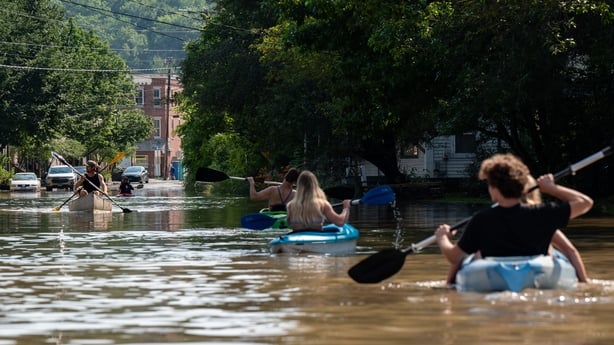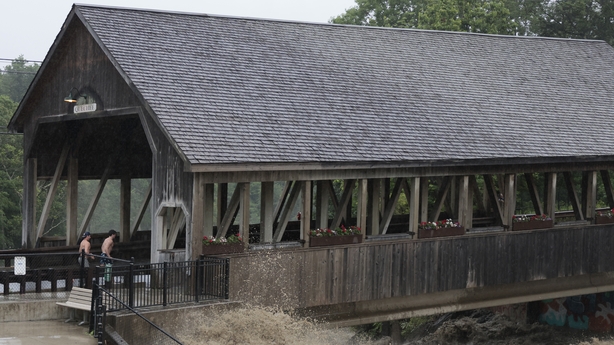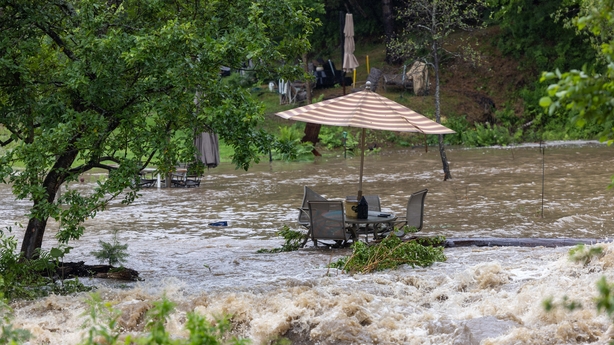A dam upstream from the Vermont state capital was holding at maximum capacity after "catastrophic" flooding shut down roadways leading out of Montpelier and trapped people in their homes.
US President Joe Biden declared a state of emergency in the northeastern state as heavy rains triggered flooding from which dozens of residents were rescued by boat.
The Wrightsville Dam, which forms a reservoir 6.4km north of Montpelier, neared the point at which a spillway would need to release water into the North Branch of the Winooski River, city officials said.
That would aggravate what the National Weather Service has called "catastrophic" flooding in Montpelier's picturesque downtown district, where people navigated the submerged streets in canoes and floodwaters reached the windows of businesses and the tops of vehicles.
The North Branch converges with a second, larger branch of the Winooski near the Vermont statehouse.
"This has never happened since the dam was built so there is no precedent for potential damage," Montpelier city manager William Fraser said in a statement.

The excessive rainfall, more than 20cm in some places, according to the National Weather Service, came after flash floods in New York state killed a woman on Sunday.
Much of the northeastern United States, including New York, New Jersey, Connecticut, Pennsylvania, Massachusetts and Vermont, was lashed by rain on Sunday and Monday, washing out bridges and leaving roads impassable.
The growing frequency and intensity of severe weather across the United States is symptomatic of global, human-driven climate change, climate scientists say.

While Vermont's capital is under water, ocean temperatures have soared to as high as 32C in Florida, Texas is sizzling under a heat dome, and California is bracing for temperatures as high as 49C in desert areas this weekend.
Much of the US northeast including parts of New York, Massachusetts and Connecticut have already had as much as 20cm of rain over the last several days.
Mr Fraser in a Facebook post urged the city's population to be prepared to move to the upper floors of their homes as highway closures made evacuations difficult or impossible.
Throughout the state, search teams have rescued 117 people from their homes and cars by swift boat, as officials fielded calls that even more people were trapped in their homes in remote areas, Mike Cannon, leader of the state's Urban Search and Rescue operation, told a briefing.
Vermont officials called the flooding the worst since Hurricane Irene reached the New England state as a tropical storm in 2011 and caused about $750 million in damages and seven deaths in the state.

The city's topography, bordered by hills with the downtown in a valley, increases the potential for flooding, Montpelier City Council member Conor Casey said.
"My wife and I live right on the river and it's about two feet from coming in the living room," Mr Casey said.
"We're a bit used to it from Irene, so it's not totally foreign, but I think the scary thing is that it feels a bit worse so far."
The flood took its toll on the regional economy, with private forecaster AccuWeather estimating damages and economic loss at $3bn to $5bn.
Most of the crops at Boyd Family Farm in Wilmington, Vermont, were lost in the storm, said Janet Boyd, who owns the 80-year-old business along with her husband and son at the southern end of the Green Mountains.
"We lost all the vegetables and only have our blueberries left," she said. "All the greens, the tomatoes, the peppers, the garlic."
Joe Miles, owner of the Montpelier-based RK Miles Building Materials, said three of his eight locations in the state were heavily damaged, with two of them cut off by flooding.
Much of his lumber and plywood inventory was lost to water damage.
"It's awful and tragic, but fortunately no one got hurt," Mr Miles said. "We'll get through it."
Meanwhile, more than 600 people also had to be evacuated from their homes in the neighboring Canadian province of Quebec following torrential rains.
In the space of 48 hours, nearly 14cm of rain fell in the Montmorency forest, near Quebec City, causing river levels to rise rapidly, authorities said.
"Similar floods are expected in winter. But this late in the summer? It's unheard of," a resident of Sainte-Brigitte-de-Laval, told Le Journal de Quebec.


